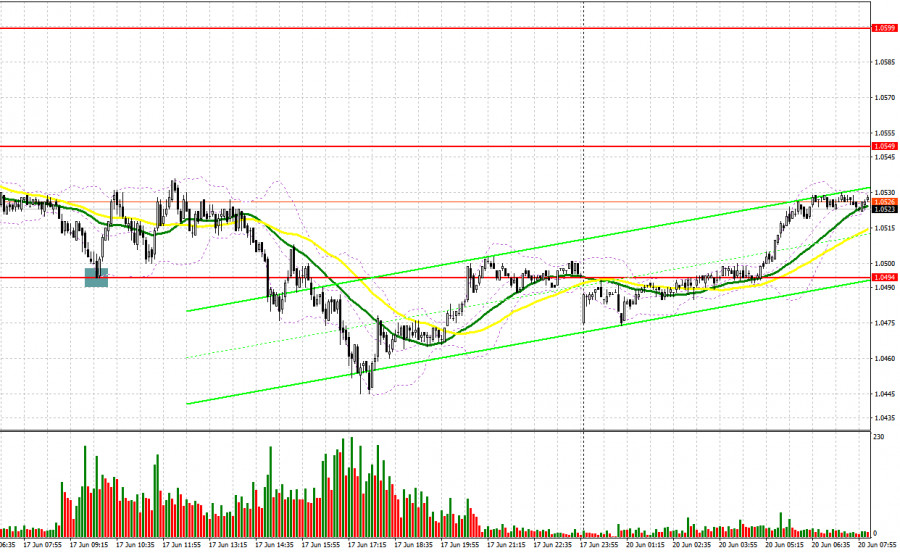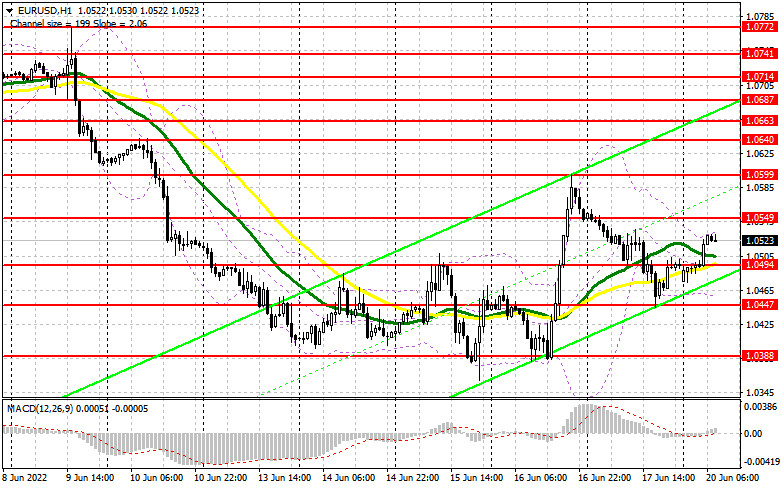
On Friday, there was just one buy signal made during the European session. Let's take a look at the M5 chart to get a picture of what happened. In the previous overview, the focus was on 1.0494 with entry points considered around it. Inflation in the eurozone came in line with the market forecast. As a result, the euro came under pressure in the first half of the day. Bulls took advantage of that and protected 1.0494 support. A false breakout there crested a buy signal. Overall, the pair rose by 40 pips. During the North American session, bears regained control over the mark of 1.0494 but failed to find a good short entry point from there. Therefore, it was unwise to sell the instrument at 1.0494.
When to go long on EUR/USD:
Pressure on the euro mounted on Friday after Chair Powell's press conference, the pair lost half of its Thursday gains. During the press conferences, Mr. Powell was hawkish about inflation and promised not to let high prices trigger a recession. On the chart, bulls took advantage of the weaker euro and pushed quotes higher. Today, no important macro events are to unfold during the European session. Germany's PPI is unlikely to somehow affect the market. Traders will focus on speeches by ECB President Lagarde and her colleagues Panetta and Lane. The fresh uptrend may start should Lagarde give a somewhat hawkish statement. In the case of a weaker euro in the first half of the day, buyers will try to defend the mark of 1.0494, with the bullish MAs passing near it. A false breakout there could give a buy signal, with the target at 1.0549 interim resistance. Should quotes break and test the barrier from top to bottom, a row of bearish stop orders may trigger and a buy signal could be created, with the target at the 1.0599 high. A more distant target is seen around 1.0640, where profit taking should be considered. In the case of bearish EUR/USD and the lack of bullish activity at 1.0494, the pair may get back in the sideways range, thus exerting additional pressure on bulls. Therefore, long entry points could be looked for after a false breakout around 1.0429 support. Long positions on a bounce could be opened from 1.0360 or around 1.0306, allowing a 30-35 pips correction intraday.
When to go short on EUR/USD:
Bears may well regain control over the market. If EUR/USD is bullish during the European session post-German inflation, a false breakout at 1.0549 interim support will generate an additional sell signal, with the target at 1.0494 support. This level is of crucial importance. An additional sell signal with the target at 1.0429 will be made after a breakout, consolidation, and a bottom-top retest of the barrier. In addition, a row of bullish stop orders could trigger. Bears need to be extremely cautious as bulls may take advantage of a correction and increase the volume of long positions. The euro is clearly oversold. Therefore, bears are less willing to open fresh short positions from the current levels. Should the price break through 1.0429 and consolidate below the mark, the target would stand at 1.0360, where all short positions should be closed. If EUR/USD is bullish during the European session and there is a lack of bearish activity at 1.0549, selling could be considered after a false breakout at 1.0599 only. A false breakout could pave the way for a new correction. Short positions on EUR/USD could be opened on a bounce from the 1.0640 high or around 1.0663, allowing a 30-35 pips downward correction.

Commitments of Traders:
The COT report for June 7 logged a sharp fall in both long and short positions. Many traders were rather cautious about the ECB meeting. In this light, the market came to a standstill. It turned out that staying away from the market was the best strategy. The ECB Governing Council said it would raise the interest rate at the upcoming meeting in the face of the 40-year high inflation in the US. Risk assets, including the euro and the pound, tumbled on Friday. A further direction of EUR/USD will depend on the Fed's monetary policy decisions. Should the central bank remain hawkish, the euro may nosedive to yearly lows. According to the COT report, long non-commercial positions fell by 6,305 to 230,248. Short non-commercial positions dropped by 4,576 to 179,705. In spite of the low exchange rate of the euro, demand for the currency is falling. In a week, non-commercial net positions declined to 50,543 from 52,272. The weekly closing price was down to 1.0710 versus 1.0742.
Indicator signals:
Moving averages
Trading is carried out above the 30-day and 50-day moving averages, indicating a rise in the euro.
Note: The period and prices of moving averages are viewed by the author on the hourly chart and differ from the general definition of classic daily moving averages on the daily chart.
Bollinger Bands
The lower band at 1.0465 stands as support. Resistance is seen at 1.0530 in line with the upper band.Indicator description:
Indicator decription:
Moving average (MA) determines the current trend by smoothing volatility and noise. Period 50. Colored yellow on the chart.Moving average (MA) determines the current trend by smoothing volatility and noise. Period 30. Colored green on the chart.Moving Average Convergence/Divergence (MACD). Fast EMA 12. Slow EMA 26. SMA 9.Bollinger Bands. Period 20Non-commercial traders are speculators such as individual traders, hedge funds, and large institutions who use the futures market for speculative purposes and meet certain requirements.Long non-commercial positions are the total long position of non-commercial traders.Non-commercial short positions are the total short position of non-commercial traders.Total non-commercial net position is the difference between short and long positions of non-commercial traders.